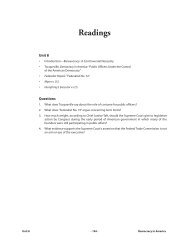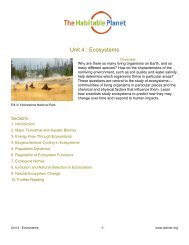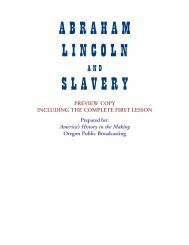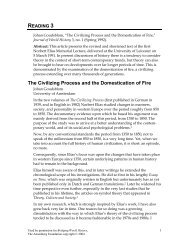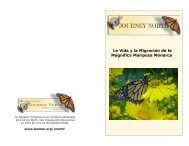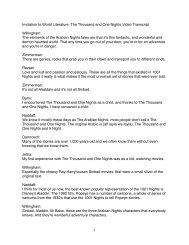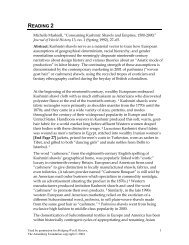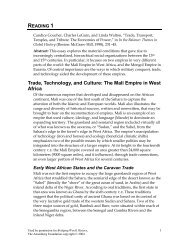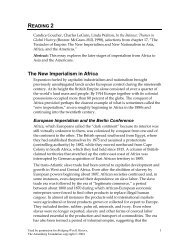UTOPIAN PROMISE - Annenberg Media
UTOPIAN PROMISE - Annenberg Media
UTOPIAN PROMISE - Annenberg Media
You also want an ePaper? Increase the reach of your titles
YUMPU automatically turns print PDFs into web optimized ePapers that Google loves.
20 UNIT 3, <strong>UTOPIAN</strong> <strong>PROMISE</strong><br />
tial? What might make it seem particularly “American”? Can you<br />
think of any nineteenth- or twentieth-century novels or films that<br />
draw on the conventions of the captivity narrative?<br />
Exploration: Compare Rowlandson’s captivity narrative with Alvar<br />
Nuñez Cabeza de Vaca’s Relation from Unit 2. How do these texts<br />
portray Native Americans differently? What do they have in common?<br />
What kind of audience does each author write for? How does<br />
each of these narratives differ from the Yellow Woman stories in<br />
Unit 1?<br />
Edward Taylor (c. 1642–1729)<br />
Edward Taylor was born in Leicestershire, England, in 1642 to<br />
Nonconformist parents of modest circumstances. In his mid-twenties,<br />
frustrated by the climate of intolerance toward Puritans, he fled<br />
England for Massachusetts. Entering Harvard with advanced standing,<br />
Taylor embarked on a course of study to prepare himself to<br />
become a minister. In 1671 he accepted a call to the ministry in the<br />
town of Westfield, a farming community on the fringes of the colony.<br />
He spent the rest of his life there, rarely leaving Westfield even for visits.<br />
Because the area was threatened by Indian attacks throughout<br />
the 1670s, Taylor’s church building had to do double duty as a fort,<br />
delaying the formal organization of the congregation as a Puritan<br />
church until 1679. As the most educated man in Westfield, Taylor<br />
served the town by assuming the roles of physician and teacher as well<br />
as minister.<br />
Taylor’s education had left him with a lasting passion for books, and<br />
his library was a distinguished one, though many of the books were<br />
his own handwritten copies of volumes he could not afford to purchase<br />
in printed form. Much of Taylor’s time was devoted to writing<br />
sermons for public presentation, but he also produced a large corpus<br />
of some of the most inventive poetry in colonial America. While he did<br />
not publish any of this poetry in his lifetime, viewing it instead as a<br />
personal aid to his spiritual meditations and as preparation for giving<br />
communion to his congregation, he did carefully collect and preserve<br />
his manuscripts. His collection was not published until the twentieth<br />
century, after it was discovered in the Yale University Library in 1937.<br />
Taylor experimented with a variety of poetic forms, composing<br />
paraphrases of biblical psalms, elegies, love poems, a long poem called<br />
God’s Determinations in the form of a debate about the nature of salvation,<br />
and his five-hundred-page Metrical History of Christianity.<br />
His best-known poems, a series of 217 verses called Preparatory<br />
Meditations, are lyric explorations of the Puritan soul and its relation<br />
to the sacrament. The poems’ struggles with complicated theological<br />
issues are carefully contained within rigidly structured six-line stanzas<br />
of iambic pentameter. While the metaphors and metaphysical conceits<br />
in Preparatory Meditations are elaborate (they are sometimes compared<br />
to the work of the English poet John Donne), much of Taylor’s<br />
other poetry is characterized by its plain-style aesthetic and its homely<br />
metaphors of farming and housekeeping. Taylor’s work is not easily



